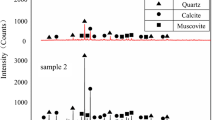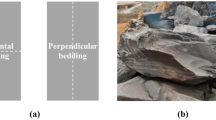Abstract
The dynamic mechanical experiments were carried out on shales with the different bedding angles (θ = 0°, 30°, 45°, 60°, 90°) using the 50 mm split Hopkinson pressure bar (SHPB) test system with the thermo-mechanical coupling equipment. Firstly, the dynamic parameter of shales, such as the stress–strain curve, peak stress, peak strain, dynamic elastic modulus, and energy partition were acquired. The failure modes of shale samples were obtained by sorting out the fragments after impact tests. Secondly, the fracture roughness of shale was obtained using the 3D profile scanner. The experimental results revealed that the shale with different bedding angle has different critical temperature, which is based on the relative transition temperature of dynamic mechanical parameters. The dynamic mechanical properties of shale vary greatly before and after the critical temperature. The absorption energy is positively correlated with the crushing degree, the dynamic compressive strength is positively correlated with the fracture roughness, and the failure degree of shale samples is closely related to the temperature. Additionally, the dynamic mechanical properties of the shales with 0° and 90° bedding angles are obviously different from the shales with 30°, 45° and 60° bedding angles. The related findings could provide significant theoretical support for exploitation of shale gas.











Similar content being viewed by others
Abbreviations
- ε i(t):
-
Incident strain pulse
- ε r(t):
-
Reflected strain pulse
- ε t(t):
-
Transmission strain pulse
- σ(t):
-
Stress of specimen
- ε(t):
-
Strain of specimen
- \( \mathop \varepsilon \limits^{ \bullet } (t) \) :
-
Strain rate of specimen
- A :
-
Cross-sectional area of the bar
- A s :
-
Cross-sectional area of the specimen
- E :
-
Elastic modulus of bar
- C :
-
Wave speed of the bar
- L s :
-
Length of specimen
- θ :
-
Bedding angle of specimen
- T :
-
Test temperature
- ν :
-
Impact velocity
- E c :
-
Dynamic elastic modulus of specimen
- S i :
-
Axial stress
- ε i :
-
Axial strain
- W i :
-
Incident energy
- W r :
-
Reflection energy
- W t :
-
Transmission energy
- W s :
-
Absorbed energy
- λ :
-
Ratio of the absorbed energy to the incident energy
- S a :
-
Arithmetic mean deviation
- Z :
-
Distance from the point on the contour of the object surface area to the reference plane
- MN :
-
Sampling points in two directions perpendicular to each other in the evaluation area
References
Armstrong R, Walley SM (2008) High strain rate properties of metals and alloys. Int Metall Rev 53(3):105–129. https://doi.org/10.1179/174328008X27779
Beis D, Bartman T, Jin SW et al (2005) Genetic and cellular analyses of zebrafish atrioventricular cushion and valve development. Development 132(18):4193–4204. https://doi.org/10.1242/dev.01970
Bobko C, Ulm F (2008) The nano-mechanical morphology of shale. Mech Mater 40(4–5):318–337. https://doi.org/10.1016/j.mechmat.2007.09.006
Bowker KA (2007) Barnett shale gas production, fort worth basin: issues and discussion. Aapg Bull 91(4):523–533. https://doi.org/10.1306/06190606018
Cho J, Kim H, Jeon S, Min K (2012) Deformation and strength anisotropy of Asan gneiss, Boryeong shale, and Yeoncheon schist. Int J Rock Mech Min Sci 50:158–169. https://doi.org/10.1016/j.ijrmms.2011.12.004
Du HB, Dai F, Liu Y et al (2020) Dynamic response and failure mechanism of hydrostatically pressurized rocks subjected to high loading rate impacting. Soil Dyn Earthq Eng 129:105927. https://doi.org/10.1016/j.soildyn.2019.105927
Gray III GT (2000) Classic split-hopkinson pressure bar testing. ASM Handbook Mech Test Eval 8:462–476. https://doi.org/10.31399/asm.hb.v08.a0003296
Guo TL, Zhang HR (2014) Formation and enrichment mode of Jiaoshiba shale gas field Sichuan basin. Pet Explor Dev 41(1):31–40. https://doi.org/10.1016/S1876-3804(14)60003-3
Hansen A, Schmittbuhl J (2003) Origin of the universal roughness exponent of brittle fracture surfaces: stress-weighted percolation in the damage zone. Phys Rev Lett 90(4):045504. https://doi.org/10.1103/PhysRevLett.90.045504
Heng S, Guo YT, Yang CH et al (2015) Experimental and theoretical study of the anisotropic properties of shale. Int J Rock Mech Min Sci 74:58–68. https://doi.org/10.1016/j.ijrmms.2015.01.003
Huang B, Li L, Tan Y, Hu R, Li X (2020) Investigating the meso-mechanical anisotropy and fracture surface roughness of continental shale. J Geophys Res Solid Earth. https://doi.org/10.1029/2019JB017828
Jarvie DM, Hill RJ, Ruble TE, Pollastro RM (2007) Unconventional shale-gas systems: the Mississippian Barnett shale of North-Central Texas as one model for thermogenic shale-gas assessment. AAPG Bull 91(4):475–499. https://doi.org/10.1306/12190606068
Jessell MW, Cox SJD, Schwarze P, Power WL (1995) The anisotropy of surface roughness measured using a digital photogrammetric technique. Geol Soc London Spec Publ 92(1):27–37. https://doi.org/10.1016/0148-9062(96)83904-0
Jin ZF, Li WX, Jin CR, Hambleton J, Cusatis G (2018) Anisotropic elastic, strength, and fracture properties of Marcellus shale. Int J Rock Mech Min Sci 109:124–137. https://doi.org/10.1016/j.ijrmms.2018.06.009
Lanaro F (2000) A random field model for surface roughness and aperture of rock fractures. Int J Rock Mech Min Sci 37(8):1195–1210. https://doi.org/10.1016/S1365-1609(00)00052-6
Li XB, Lok TS, Zhao J (2005) Dynamic characteristics of granite subjected to intermediate loading rate. Rock Mech Rock Eng 38(1):21–39. https://doi.org/10.1007/s00603-004-0030-7
Li WX, Rezakhani R, Jin CR, Zhou X, Cusatis G (2017a) A multiscale framework for the simulation of the anisotropic mechanical behavior of shale. Int J Num Anal Methods Geomech 41(14):1494–1522. https://doi.org/10.1002/nag.2684
Li X, Duan YT, Li SD, Zhou R (2017b) Study on the progressive failure characteristics of Longmaxi shale under uniaxial compression conditions by X-ray micro-computed tomography. Energies (Basel) 10(3):303. https://doi.org/10.3390/en10030303
Liu J, Zhang H (2013) Experimental study for dynamic mechanical properties of shale using split Hopkinson pressure bar. Disaster Adv 6(11):38–42
Liu J, Li Y, Zhang H (2015) Study on shale’s dynamic damage constitutive model based on statistical distribution. Shock Vib 2015:286097. https://doi.org/10.1155/2015/286097
Loucks RG, Ruppel SC (2007) Mississippian Barnett shale: lithofacies and depositional setting of a deep-water shale-gas succession in the Fort Worth Basin Texas. AAPG Bull 91(4):579–601. https://doi.org/10.1306/11020606059
Luo Y, Wang G, Li X et al (2020) Analysis of energy dissipation and crack evolution law of sandstone under impact load. Int J Rock Mech Min Sci (Oxford, England : 1997) 132:104359. https://doi.org/10.1016/j.ijrmms.2020.104359
Masri M, Sibai M, Shao JF, Mainguy M (2014) Experimental investigation of the effect of temperature on the mechanical behavior of tournemire shale. Int J Rock Mech Min Sci (Oxford, England : 1997) 70:185–191. https://doi.org/10.1016/10.1016/j.ijrmms.2014.05.007
Nemat-Nasser S, Li Y, Isaacs J (1994) Experimental/computational evaluation of flow stress at high strain rates with application to adiabatic shear banding. Mech Mater 17(2–3):111–134. https://doi.org/10.1016/0167-6636(94)90053-1
Niandou H, Shao JF, Henry JP, Fourmaintraux D (1997) Laboratory investigation of the mechanical behaviour of tournemire shale. Int J Rock Mech Min Sci (Oxford, England : 1997) 34(1):3–16. https://doi.org/10.1016/s1365-1609(97)80029-9
Peng K, Liu ZP, Zou QL, Wu Q, Zhou J (2020) Mechanical property of granite from different buried depths under uniaxial compression and dynamic impact: an energy-based investigation. Powder Technol 362:729–744. https://doi.org/10.1016/j.powtec.2019.11.101
Rexer TFT, Benham MJ, Aplin AC, Thomas KM (2013) Methane adsorption on shale under simulated geological temperature and pressure conditions. Energy Fuel 27(6):3099–3109. https://doi.org/10.1021/ef400381v10.1021/ef400381v
Ross DJK, Bustin RM (2009) The importance of shale composition and pore structure upon gas storage potential of shale gas reservoirs. Mar Petrol Geol 26(6):916–927. https://doi.org/10.1016/j.marpetgeo.2008.06.004
Sayers CM (2013) The effect of anisotropy on the young’s moduli and poisson’s ratios of shales. Geophys Prospect 61(2):416–426. https://doi.org/10.1111/j.1365-2478.2012.01130.x
Sheng M, Cheng Z, Tian S, Ge H, Li G (2017) Experimental Study On Dynamic Failure Behaviors of Gas Shale and the Relation to Drilling Fluid. 2017 ISRM Young Scholars' Symposium on Rock Mechanics.
Sone H, Zoback MD (2013) Mechanical properties of shale-gas reservoir rocks—part 1: static and dynamic elastic properties and anisotropy. Geophysics 78(5):D381–D392. https://doi.org/10.1190/geo2013-0050.1
Song B, Chen W (2006) Energy for specimen deformation in a split Hopkinson pressure bar experiment. Exp Mech 46(3):407–410. https://doi.org/10.1007/s11340-006-6420-x
Subhash GRG (1994) Critical appraisal of limiting strain rates for compression testing of ceramics in a split hopkinson pressure bar. J Am Ceram Soc 77(1):263–267. https://doi.org/10.1111/j.1151-2916.1994.tb06987.x
Sun Q, Zhang Z et al (2019) Study on the bedding effect and damage constitutive model of black shale under dynamic loading. Chin J Rock Mech Eng 38(7):1319–1331. https://doi.org/10.13722/j.cnki.jrme.2018.1333
Suo Y, Chen ZX, Rahman SS, Chen X (2020) Experimental study on mechanical and anisotropic properties of shale and estimation of uniaxial compressive strength. Energy Sour Part A Recovery Util Environ Eff. https://doi.org/10.1080/15567036.2020.1779873
Surnam BYR, Oleti CV (2013) Using three-dimensional surface roughness parameters in analysis of atmospheric corrosion degradation of carbon steel. Corros Eng Sci Technol 47(2):96–106. https://doi.org/10.1179/1743278211Y.0000000030
Wang Y, Li CH (2017) Investigation of the P- And S-wave velocity anisotropy of a Longmaxi formation shale by real-time ultrasonic and mechanical experiments under uniaxial deformation. J Petrol Sci Eng 158:253–267. https://doi.org/10.1016/j.petrol.2017.08.054
Wu ZH, Lou YL, Yin S et al (2020) Acoustic and fractal analyses of the mechanical properties and fracture modes of bedding-containing shale under different seepage pressures. Energy Sci Eng 8(10):3638–3658. https://doi.org/10.1002/ese3.772
Yang Y, Zoback M (2016) Viscoplastic deformation of the bakken and adjacent formations and its relation to hydraulic fracture growth. Rock Mech Rock Eng 49(2):689–698. https://doi.org/10.1007/s00603-015-0866-z
Yang G, Liu J, Li X, Bi J (2020a) Effect of temperature on shale strength under dynamic impact loading. Arab J Geosci. https://doi.org/10.1007/s12517-020-05435-2
Yang R, Li W, Yue Z (2020b) Comparative study on dynamic mechanical properties and energy dissipation of rocks under impact loads. Shock Vib 8:1–15. https://doi.org/10.1155/2020/8865099
Zhang ZX, Kou SQ, Jiang LG (2000) Effects of loading rate on rock fracture: fracture characteristics and energy partitioning. Int J Rock Mech Min Sci 37(5):745–762. https://doi.org/10.1016/S1365-1609(00)00008-3
Zhang TW, Ellis GS, Ruppel SC, Milliken K, Yang R (2012) Effect of organic-matter type and thermal maturity on methane adsorption in shale-gas systems. Org Geochem 47:120–131. https://doi.org/10.1016/j.orggeochem.2012.03.012
Zhang LH, Li JC, Tang HM, Guo J (2014) Fractal pore structure model and multiplayer fractal adsorption in shale. Fractals 22(03):1440010. https://doi.org/10.1142/S0218348X14400106
Acknowledgements
This research was financially supported by the National Key Research and Development Project of China No.2020YFA0711800 and the National Natural Science Foundation of China No.12072363. The authors are grateful to the Advanced Analysis and Computation Center of China University of Mining and Technology.
Author information
Authors and Affiliations
Author notes
Ning Luo and Xueru Fan contributed equally to this work.
Corresponding author
Additional information
Publisher's Note
Springer Nature remains neutral with regard to jurisdictional claims in published maps and institutional affiliations.
Rights and permissions
About this article
Cite this article
Fan, X., Luo, N., Liang, H. et al. Dynamic Breakage Characteristics of Shale with Different Bedding Angles under the Different Ambient Temperatures. Rock Mech Rock Eng 54, 3245–3261 (2021). https://doi.org/10.1007/s00603-021-02463-6
Received:
Accepted:
Published:
Issue Date:
DOI: https://doi.org/10.1007/s00603-021-02463-6




